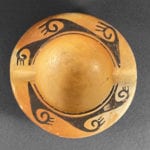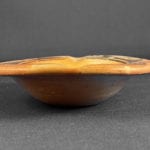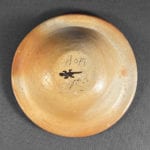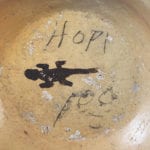This small bowl is the most prosaic of all Hopi tourist trinkets: an ashtray. The maker is unknown, though indicated with a lizard identification mark on the bottom. …..And that is why I include it in a collection with many masterpiece of Hopi art.
Masterpieces are great, but the common items made by Hopi women to support their families were relatively insignificant pots like this. Thus 2019-01 serves as a monument to all those Hopi women and all that clay.
The walls of this ashtray are substantial but even, just what you’d want for this functional item. It is well fired with blushing from the dung fire most noticeable on the bottom. Stains indicate it served its purpose well.
The design is repeated six times on the flared rim, three times on either side of the cigarette rests. Simple and graceful, the design has at least two interpretations. First it is an abstracted version of the rainbird element from Zuni but also found on earlier Polacca Hopi pottery (1994-14 and 2014-06) and occasionally used in modern times (1992-04). Second, it was interpreted by Alexander Steven as water flowing in a series of eddies, recalling the place of emergence and the house of Masau at the bottom of the Grand Canyou (Patterson, 1994:240).





